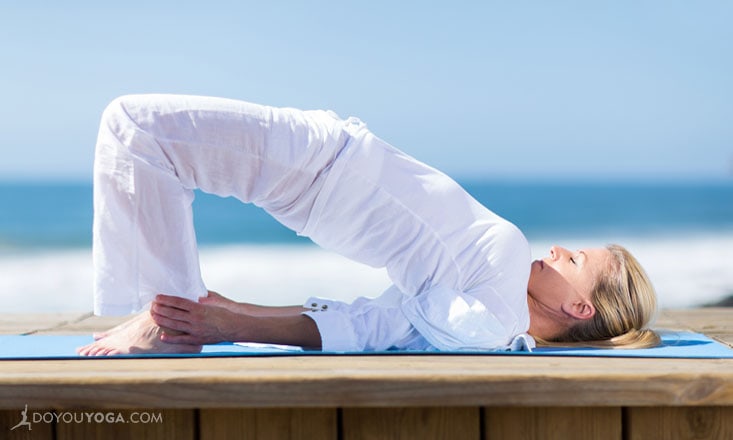Yogis (well many of us) believe we are born with a certain number of breaths. That said, we’re wise to breathe slowly, deeply, and meaningfully! You’re not in any hurry are you?
Maximum lung capacity (vital capacity) is about three liters on average, yet typically we only breathe in and out (tidal volume) about 500 mL, or half a liter. So, not only is the number of our breaths finite, we’re also wasting most of this number.
Through various yogic breathing practices, we can gain awareness and take a level of that consciousness with us throughout the day, in each and every breath we take. Here are ten ways to breathe better through yoga.
1. Standing Deep Breathing Pranayama
Pranayama is the Sanskrit term for controlling the movement of our life-force energy (prana) through controlling the breath. There are a number of different breathing techniques to do this.
Standing Deep Breathing in the Bikram practice is a heating and detoxifying exercise performed at the start of class. The inhalation is through the nose for a count of six, with fingers interlaced under the chin and arms lifted up so that elbows frame the face.
The belly sucks in as the diaphragm contracts and lungs are expanded to their maximum capacity. This pushes fresh warm oxygen to your muscles and organs and gets the blood pumping.
In the exhale through the mouth with a loud ‘ha’ sound (also a count of six), the head tilts back and the elbows are brought down and back together off the chest, with the aim of getting rid of all stale air and tension.
2. Ujjayi Breathing
Also called Psychic Breath, the inhalation and exhalation in this pranayama is through the nose, with air forced up and down against the back of the throat, compressing the epiglottis and making a soft, rasping ‘oceanic’ sound.
Ujjayi Breathing is settling and rhythmic—a great practice to accompany asana (moving meditation).
3. Lion’s Breath
This technique relieves tension in the face and stress in general. Roaring like a lion (a loud ‘ha’ sound) with your tongue poked out while exhaling any unwanted energy feels great.
Lion’s Breath can be practiced in a number of postures, while Lion Pose itself, Simhasana, involves kneeling with ankles crossed, sitting back on the heels and placing arms firmly on your thighs, fingers splayed like feline paws.
4. Belly Breathing
This breathing method quickly calms and resets the nervous system and is commonly used in Savasana or for general relaxation.
Also called Abdominal or Diaphragmatic Breathing, this deep form of respiration is achieved from contracting the diaphragm (a muscled located horizontally between the abdomen and chest cavity) and watching your belly rise and fall while your ribcage is gently controlled through the diaphragm.
This alleviates the habit many of us have of shallow ‘chest breathing.’
5. Alternate Nostril Breathing (Nadi Shodhana)
A calming and centering technique, Nadi Shodhana balances the flow of prana up and down the left and right nadis (energy channels) through alternating inhalation and exhalation through the nostrils.
With the left hand loosely in the lap, the thumb (right nostril) and ring finger (left nostril) of the right hand are used to open and close the nostrils, while the index and middle fingers are placed between the brow at the third eye.
First exhale, inhale through one nostril with the ring finger or thumb compressing the other, and then swap to the other nostril. A round of nine alternate breaths makes a great prelude to meditation. It’s also fun to try with kids to build their hand-eye coordination.
6. Bee Humming or Bee Breath (Bhramari)
This pranayama is instantly calming and great for letting go of anger. Place your index fingers onto the cartilage of your ears (against your cheek) to block out external sound, inhale and make a constant, high-pitched bee-humming sound.
You can press your fingers in and out, or leave your fingers pressed in. This pattern can be repeated six to seven times. The kids will love it and together the whole family can create a calming chorus in a humming hive.
7. Kapalbhati Blowing
Kapalbhati flips normal breathing with the focus on short, sharp exhalations while the inhalation takes care of itself. It tones and purifies, releasing any last stale air from the body after practicing asana, and cleanses the sinuses and respiratory system.
Imagine pulling your bellybutton in and out with a string as you blow out sixty strong, quick breaths.
8. Attaching an Emotion
Not a technique as such, this is a way to use breath as a focus point for receiving and releasing. Imagine breathing in love and breathing out anger, or inhale joy and exhale gratitude or forgiveness.
9. Focusing on Inhalation
Make the inhalation the focus by simply lengthening it compared to the exhale. This may help you feel full and energized.
10. Focusing on Exhalation
Make the exhalation longer than the inhalation and you may feel a great sense of surrender and release—perfect when holding poses in Yin yoga.
Finally, don’t forget the importance of holding your breath; become aware of the stillness between the inhalation and exhalation and acknowledge the power of possibility in this silent space. Now, breathe easy.


